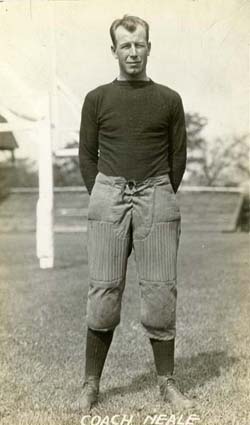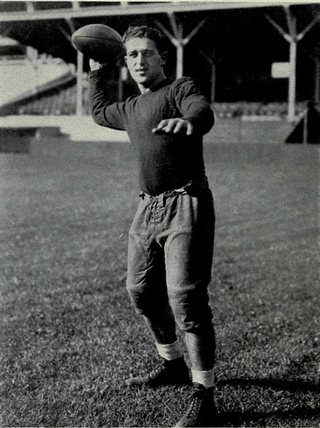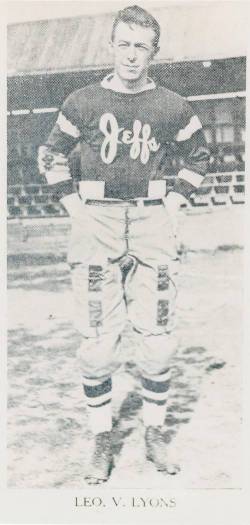Related Research Articles

The Providence Steam Rollers were a professional American football team based in Providence, Rhode Island in the National Football League (NFL) from 1925 to 1931. Providence was the first New England team to win an NFL championship. The Steam Roller won the league's championship in 1928, which is the latest NFL championship win by a defunct team to date. Most of their home games were played at the Cycledrome, a 10,000-seat stadium that was built as a velodrome for bicycle races.
Buffalo, New York had a turbulent, early-era National Football League team that operated under multiple names and several different owners between the 1910s and 1920s. The early NFL-era franchise was variously called the Buffalo All-Stars from 1915 to 1917, Buffalo Niagaras in 1918, the Buffalo Prospects in 1919, Buffalo All-Americans from 1920 to 1923, Buffalo Bisons from 1924 to 1925 and in 1927 and 1929, and the Buffalo Rangers in 1926. The franchise, which was experiencing financial problems in 1928, did not participate in league play that season.
The Rochester Jeffersons were an American football team based in Rochester, New York from 1898 to 1925. The team was a founding member of the National Football League (NFL), in which they played from 1920 to 1925.
The Tonawanda Kardex was an American football team active between 1916 and 1921. It played its games in Tonawanda, New York, a suburb of Buffalo with close ties to North Tonawanda, New York where American Kardex was founded. The team is most notable for its one game as a member of the American Professional Football Association in the 1921 season. They are easily the shortest-lived team in the league's history, and the shortest-lived known team in North American major league sports history.
The 1920 APFA season was the inaugural season of the American Professional Football Association, renamed the National Football League in 1922. An agreement to form a league was made by four independent teams from Ohio on August 20, 1920, at Ralph Hay's office in Canton, Ohio, with plans to invite owners of more teams for a second meeting on September 17, 1920. The "American Professional Football Conference" (APFC) was made up of Hay's Canton Bulldogs, Akron Pros, the Cleveland Tigers and the Dayton Triangles, who decided on a six-game schedule to play each other at home-and-away, an agreement to respect each other's player contracts, and to take a stand against signing college students whose class had not yet graduated.

Alfred Earle "Greasy" Neale was an American football and baseball player and coach.

Wilbur Francis "Pete" Henry was an American football player, coach, and athletic administrator. He was a charter inductee into both the College Football Hall of Fame in 1951 and the Pro Football Hall of Fame in 1963.

Harry Lawrence Newman was an American professional football player who was a quarterback in the National Football League (NFL) and American Football League. He played college football for the Michigan Wolverines (1930–32), for whom in 1932 he was a unanimous first-team All-American, and the recipient of the Douglas Fairbanks Trophy as Outstanding College Player of the Year, and the Helms Athletic Foundation Player of the Year Award, he was later inducted into the College Football Hall of Fame. He then played professionally for the New York Giants (1933–35), earning All-Pro honors, before joining the Brooklyn/Rochester Tigers (1936–37).
A nameless professional American football team, based in Syracuse, New York and generically known as the Syracuse Pros or Syracuse Eleven, was once thought to have joined the American Professional Football Association (now the National Football League for the 1921 season. The team was coached by Mike Purdy and managed by Andy Friedman. Syracuse University multi-sport standout John Barsha was the team's franchise player.
The 1920 Buffalo All-Americans season was the franchise's inaugural season with the American Professional Football Association (APFA), an American football league, and fifth total as a team. The All-Americans entered 1920 coming off a 9–1–1 record in 1919 as the Buffalo Prospects in the New York Pro Football League (NYPFL). Several representatives from another professional football league, the Ohio League, wanted to form a new national league, and thus the APFA was created.
The 1920 Cleveland Tigers season was the franchise's inaugural season in the American Professional Football Association (APFA) and fifth total as an American football team. The Tigers entered the season coming off a 5-win, 2-loss, 2-tie (5–2–2) record in 1919. After the 1919 season, several representatives from the Ohio League, a loose organization of professional football teams, wanted to form a new professional league; thus, the APFA was created.
The 1920 Muncie Flyers season was the franchise's inaugural season in the American Professional Football League (APFA)—later named the National Football League. The Flyers entered the season coming off a 4–1–1 record in 1919. Several representatives from the Ohio League wanted to form a new professional league; thus, the APFA was created. The 1920 team only played in one game that counted in the standings: a 45–0 loss against the Rock Island Independents. This game and the Columbus Panhandles–Dayton Triangles on the same date is considered to be the first league game featuring two APFA teams. The Flyers tried to schedule other games, but the opponents canceled to play better teams. As a result, the Flyers had to play the rest of the season's game versus local teams. In week 10, the Flyers won a game against the Muncie Offers More AC for the Muncie City Championship. No players from the 1920 Muncie Flyers were listed on the 1920 All-Pro Team, and no player has been enshrined in the Pro Football Hall of Fame.
The 1920 Rochester Jeffersons season was the franchise's inaugural season in the American Professional Football Association (APFA) and thirteenth as an American football team. The Jeffersons entered 1920 coming off a six-win, two-loss, two-tie (6–2–2) record in the New York Pro Football League (NYPFL) where it lost the championship game to the Buffalo Prospects. Several representatives from another professional football league, the Ohio League, wanted to form a new national league, and thus the APFA was created.
The New York Pro Football League (NYPFL) was a professional American football league, active in the 1910s, and based in upstate New York, primarily Western New York. Between 1920 and 1921, the league's best teams were absorbed into the National Football League, though none survive in that league. It was one of the biggest challengers to the Ohio League in professional football in the 1910s.
James Marcellus Kendrick was a professional American football player during the early years of the National Football League (NFL) with the Toledo Maroons, Canton Bulldogs, Louisville Brecks, Chicago Bears, Hammond Pros, Buffalo Bisons, Rochester Jeffersons, Rock Island Independents, Buffalo Rangers and the New York Giants. Kendrick was a part of the Bulldogs' 1922 NFL championship team and the Giants' 1927 NFL Championship team.

Leo V. Lyons was a co-founder of the National Football League (NFL). He was a player, manager, coach and owner of the Rochester Jeffersons from 1908 to 1925.
The McKeesport Olympics were a professional football team from McKeesport, Pennsylvania from 1896 until around 1940. The Olympics were considered one of the top football teams in Pennsylvania from 1910 until 1919.
The city and metropolitan area of Rochester, New York, has several sports teams. Rochester was named the top minor league sports market in the country by Street & Smith's Sports Business Journal in July 2005, the number 10 "best golf city" in America by Golf Magazine in 2007, and the fifth-best "sports town" in the country by Scarborough Research in September 2008.
Alfred Scotchard "Shag" Sheard was an American football player and coach.
Gerald A. Quigley was an American football quarterback who played one season in the American Professional Football Association (APFA) and one in the New York Pro Football League (NYPFL) for the Rochester Jeffersons. He did not play college football.
References
1919 Rochester Jeffersons complete record. Professional Football Researchers Association. Retrieved 2011-01-14.